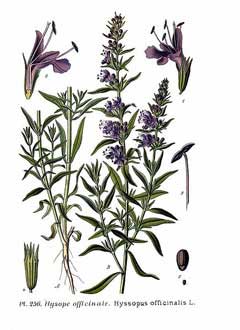
Hyssop
Latin Name: Hyssopus officinalis
USDA Hardiness: 5-10
Native Range: TEMPERATE ASIA: Armenia, Azerbaijan, Dagestan, Russian Federation, Turkey,Iran (north). EUROPE: Czechoslovakia (Czech Republic and Slovakia), Austria, Switzerland, Hungary, Ukraine (incl. Krym), Former Yugoslavia, Albania, Bulgaria, Italy, Spain, France, AFRICA: Algeria (north), Morocco.
Edibility Rating: 2 / 5
Medicinal Rating: 3 / 5
Region:
Family:
Plant Type:
Medicinal Uses
Edible Uses
Edible Parts: Flowers Leaves Oil Shoots | Edible Uses: Condiment OilLeaves and young shoot tips - raw or used as a flavouring in soups, salads etc[4, 14, 183]. A strongly aromatic flavour, somewhat like a cross between sage and mint, it has fallen out of favour in recent years[4, 238]. It can be used fresh or dried[21]. Flowers - raw. Added to salads[183]. An essential oil from the plant is used as a food flavouring[183].
Cultivation
Landscape Uses:Border, Specimen. Prefers a light, dry calcareous soil and a sunny position[1, 14, 37, 52]. A very cold-hardy plant, when dormant it can tolerate temperatures down to about -25°c[187]. Hyssop has very aromatic leaves and is commonly grown in the herb garden where it makes a good edging plant to a border[4]. There are some named varieties[183]. The plant needs to be trimmed regularly to keep it in shape, untrimmed plants will soon degenerate. Spring is the best time to trim the plants[238]. It is probably best to replace the plants every few years. The flowers have a rich aromatic fragrance[245]. Hyssop is a very good plant for attracting bees and butterflies to the garden[4, 20]. It is a good companion plant to grow with grapes, but it grows badly with radishes[14, 18, 20]. Special Features:Edible, Fragrant foliage, Not North American native, Naturalizing, Attracts butterflies, Suitable for cut flowers, Suitable for dried flowers, Attractive flowers or blooms. In garden design, as well as the above-ground architecture of a plant, root structure considerations help in choosing plants that work together for their optimal soil requirements including nutrients and water. The root pattern is fibrous dividing into a large number of fine roots [2-1]. Hyssop is typically harvested in the summer when the flowers are in full bloom. Hyssop flowers from mid-summer to early autumn producing spikes of small, tubular flowers. Hyssop is considered a fast-growing herb, typically reaching full height (about 30 to 60 cm or 1 to 2 feet) within the first year of growth.
Known Hazards
Volatile oil can cause convulsions. Avoid with epilepsy of fits. Diarrhoea and indigestion rare [301].
Habitats
Old walls and buildings, stony places[9, 17]. Dry hills and rock ledges to 2200 metres in Turkey[187].
